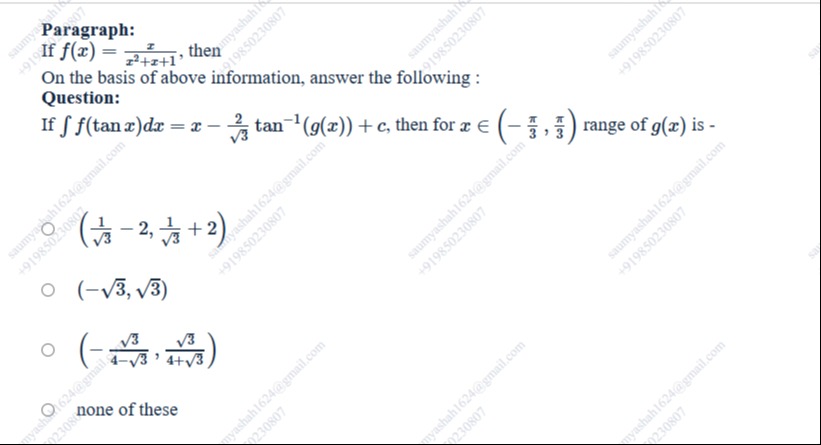Question
Question: If $f(x) = \frac{x}{x^2+x+1}$, then If $\int f(\tan x)dx = x - \frac{2}{\sqrt{3}} \tan^{-1}(g(x)) +...
If f(x)=x2+x+1x, then
If ∫f(tanx)dx=x−32tan−1(g(x))+c, then for x∈(−3π,3π) range of g(x) is -

(31−2,31+2)
(−3,3)
(−4−33,4+33)
none of these
(31−2,31+2)
Solution
The given function is f(x)=x2+x+1x. We are given the integral equation ∫f(tanx)dx=x−32tan−1(g(x))+c. Substitute x with tanx in f(x): f(tanx)=(tanx)2+tanx+1tanx=tan2x+tanx+1tanx.
Differentiate the given integral equation with respect to x: dxd(∫f(tanx)dx)=dxd(x−32tan−1(g(x))+c) f(tanx)=1−321+(g(x))21g′(x) tan2x+tanx+1tanx=1−321+(g(x))2g′(x) 321+(g(x))2g′(x)=1−tan2x+tanx+1tanx=tan2x+tanx+1tan2x+tanx+1−tanx=tan2x+tanx+1tan2x+1=tan2x+tanx+1sec2x. 1+(g(x))2g′(x)=23tan2x+tanx+1sec2x.
We know that dxdtan−1(h(x))=1+(h(x))2h′(x). We need to find g(x) such that 1+(g(x))2g′(x) matches the expression on the right-hand side. Consider the denominator tan2x+tanx+1. We can complete the square for tanx: tan2x+tanx+1=(tanx+21)2+1−41=(tanx+21)2+43. So, tan2x+tanx+1sec2x=(tanx+21)2+43sec2x. We want to express this in the form 1+y2h′(x): (tanx+21)2+43=43[43(tanx+21)2+1]=43[(23tanx+21)2+1]=43[(32tanx+1)2+1]. So, tan2x+tanx+1sec2x=43[(32tanx+1)2+1]sec2x=341+(32tanx+1)2sec2x.
Now substitute this back into the equation for 1+(g(x))2g′(x): 1+(g(x))2g′(x)=23⋅341+(32tanx+1)2sec2x=321+(32tanx+1)2sec2x.
Consider the function h(x)=32tanx+1. Its derivative is h′(x)=32sec2x. Then 1+(h(x))2h′(x)=1+(32tanx+1)232sec2x=321+(32tanx+1)2sec2x. This matches the expression for 1+(g(x))2g′(x). This implies that g(x) is proportional to h(x) or g(x) is h(x) plus a constant. However, the form of the integral suggests g(x) is exactly h(x). Let's verify the integral by integrating 321+(32tanx+1)2sec2x. Let u=32tanx+1. Then du=32sec2xdx. ∫321+(32tanx+1)2sec2xdx=∫1+u2du=tan−1(u)+C′=tan−1(32tanx+1)+C′. The given integral is ∫f(tanx)dx=x−32tan−1(g(x))+c. We calculated 321+(g(x))2g′(x)=1−f(tanx). Integrating this gives ∫321+(g(x))2g′(x)dx=∫(1−f(tanx))dx. 32∫1+(g(x))2g′(x)dx=x−∫f(tanx)dx. 32tan−1(g(x))=x−∫f(tanx)dx+constant. ∫f(tanx)dx=x−32tan−1(g(x))+constant. This confirms that g(x)=32tanx+1.
Now we need to find the range of g(x) for x∈(−3π,3π). For x∈(−3π,3π), the function tanx is strictly increasing. The range of tanx for x∈(−3π,3π) is (tan(−3π),tan(3π))=(−3,3). Let y=tanx. The range of y is (−3,3). g(x)=32tanx+1=32y+1. We need to find the range of 32y+1 for y∈(−3,3). The function 32y+1 is a linear function of y with a positive slope, so it is strictly increasing. The range is (32(−3)+1,32(3)+1). Lower bound: 3−23+1=31−323=31−2. Upper bound: 323+1=323+31=2+31. The range of g(x) is (31−2,31+2).
The range of g(x) is (31−2,31+2).
